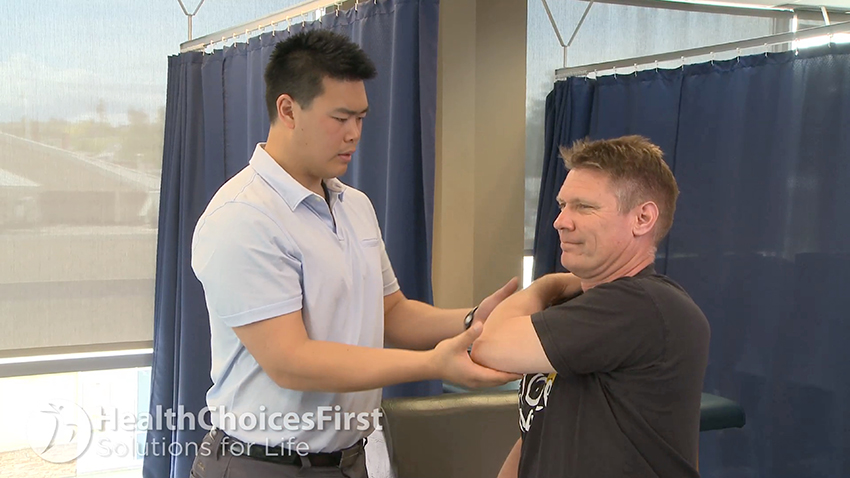Chronic Disease Education
Acute Condition Education
Working with your Family Physician
Working with Allied Care Providers
Shoulder Dislocation

Knowledge is Power.
True/False - Quiz: Do You Understand Shoulder Dislocation?
Information - Shoulder Dislocation
 Shoulder instability or shoulder dislocation occurs primarily in the younger, active athletic population. Generally, patients that are under 25 who suffer a first-time dislocation are at a relatively high risk of recurrent dislocations—upwards of 85 percent. Those patients are at risk for further damage to their shoulder every time they dislocate.
Shoulder instability or shoulder dislocation occurs primarily in the younger, active athletic population. Generally, patients that are under 25 who suffer a first-time dislocation are at a relatively high risk of recurrent dislocations—upwards of 85 percent. Those patients are at risk for further damage to their shoulder every time they dislocate.
Treatment for a Shoulder Dislocation
In older patients, the main risk with a shoulder dislocation is having an associated rotator cuff tear, or developing a post-dislocation stiff or frozen shoulder because it’s been immobilized for too long. Patients who suffer their first dislocation usually encounter a significant amount of pain as the shoulder comes out of joint. If you’re on the field and there’s a team trainer or somebody available that can put the shoulder back in joint, that’s the best-case scenario. However, if it’s not possible to put it back in joint on the field of play then you’re likely going to have to go to the emergency department to get a physician to put it back in joint.
Surgery for Shoulder Dislocation
If you’ve suffered a first-time shoulder dislocation or have recurrent dislocations of your shoulder, you should seek the advice of your family physician and get a referral to an orthopaedic surgeon so you can discuss the surgical management of this problem. After a first-time dislocation, patients usually get X-rays before it gets put back into joint. Once it’s put back in joint, X-rays are typically repeated on the same day to make sure that there are no other associated fractures with the dislocation.
If you develop recurrent dislocations, the most common treatment is surgical reconstruction of the damaged tissues in the shoulder joint. This usually involves an arthroscopic day procedure, where the surgeon identifies the torn labrum or ligaments that have occurred with each shoulder dislocation. The orthopaedic surgeon passes sutures through the ligaments and reattaches them to keep the ball in the socket.
 Following surgery for recurrent dislocations of the shoulder, your arm is placed in a sling for protection. You’re generally allowed to move through a limited range of motion and begin physiotherapy after your wounds have healed, which usually occurs after the first to second week.
Following surgery for recurrent dislocations of the shoulder, your arm is placed in a sling for protection. You’re generally allowed to move through a limited range of motion and begin physiotherapy after your wounds have healed, which usually occurs after the first to second week.
Most patients will benefit from physiotherapy to get their range of motion back, decrease pain and increase strength. You should regain your range of motion within the first two to three months and return to your sport after about six months.
Talk to your healthcare provider if you'd like more information on shoulder dislocation.
Visit HealthChoicesFirst.com for more videos and resources on sports health.
Print this Action Plan and check off items that you want to discuss with your healthcare provider
-
In older patients, the main risk with a shoulder dislocation is having an associated rotator cuff tear, or developing a post-dislocation stiff or frozen shoulder because it’s been immobilized for too long.
-
If a team trainer or other healthcare professional isn't on the field to put a first-time dislocated shoulder into place, you’re likely going to have to go to the emergency department to get a physician to put it back in joint.
-
After a first-time dislocation, patients usually get X-rays before it gets put back into joint. Once it’s put back in joint, X-rays are typically repeated on the same day to make sure that there are no other associated fractures with the dislocation.
-
If you develop recurrent dislocations, the most common treatment is surgical reconstruction of the damaged tissues in the shoulder joint. This usually involves an arthroscopic day procedure, where the surgeon identifies the torn labrum or the torn ligaments are that have occurred with each shoulder dislocation.
-
Most patients will benefit from physiotherapy to get their range of motion back, decrease pain and increase strength. You should regain your range of motion within the first two to three months and return to your sport after about six months.
